Practical tips on how to prepare a winter dream engine
Practical tips on how to prepare a winter dream engine
Due to weather conditions that hit our country in the winter, many motorcycles prefer their two-wheeled stalls over winter, not wanting to be brave at temperatures falling below zero.
Nevertheless, as a large selection of winter suits, protective winter gloves and heating suits are available today, driving during the winter period has become a more feasible option.
However, if winter driving does not sound tempting, then you will want to leave your motorbike in the garage for several months. In that case, you need to pay attention to certain things to avoid expensive repairs on the spring.
If your pet is not properly cooked for the winter, there may be more problems with battery discharge, fuel tank tanning, faded paint, rust, and drill, and in some circumstances serious damage to the engine may occur.
Location
The space for the "winter sleep" of your machine should be a dry and safe place, far from the impact of weather conditions, as well as the minimum of daily temperature variations.
Choose a place away from the window; The paint can fade due to ultraviolet radiation, which can also affect the plastic parts badly. Direct sunlight can increase the temperature of the storage part and lead to a rise in condensation.
Use a cover seal designed for this purpose. Do not use impregnated or cotton linen, as it will retain moisture, which may result in rust and the appearance of the mold.
Fuel system
When working with the fuel system, select rooms with good ventilation. Do not use cigarettes in your mouth to work areas where you are holding gasoline, and avoid any kind of flames and sparks.
Proper preparation of the fuel tank is vital when preparing a motorcycle for the winter. There are two ways to prepare a storage tank:
The first method is to completely drain the tank, and if you opt for this approach, spray the interior of the reservoir with an anti-corrosion agent.
Another method (recommended for fuel injection models) is to fill the tank to the top (literally to the shutter) with a "fresh" fuel.
If you are sure that at least 4 to 6 weeks, add a stabilizer or similar agent to the tank before removing the fuel itself. If the standstill period lasts longer than 3 months, fully empty the tank and close all the valves on the inlet.
When the fuel lasts for a long time in the tank, there is a "deterioration", that is, a precipitate is created that can blow up the leads and even penetrate the carburettor itself. Adding a stabilizer prevents something like that, and also prevents accumulation of moisture in the tank.
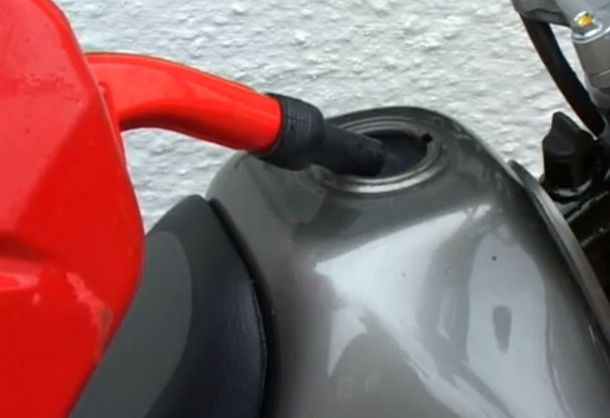
Most engine engineers change the oil at the beginning of the season, but it's our job to do this before the winter motorcycle is stored. This can prevent corrosion, primarily due to acids produced as a by-product of combustion.
Before changing the oil, transport your pet until it reaches a normal operating temperature and then access it yourself.
Cylinders (internal corrosion protection)
Cylinder walls can rupture if the engine does not work for more than a couple of weeks. The first thing to do is start the motorcycle and bring it to a normal operating temperature so that moisture evaporates. It would be nice to drive it a bit and then turn it off. After the motor has cooled down, remove the spark plug (or spark plug) and pour about 25 milliliters (one bucket of spoon) of the clean engine oil of the one you normally use into the cylinder (or cylinder). Manually "drive" the engine and insert at the highest level of transmission. This will create a type of oil mask in the engine and then replace the spark plugs in place.
Battery
During the storage period, it is best to remove the battery from your motorcycle.
If it is a conventional battery, check the electrolyte level. In each of the cells where the level is low add distilled water. Required distillation, not with fountain, because the "freighter" will drastically shorten the life of the battery.
If you do not refill the battery from time to time, it will soon be discharged so that during winter you have to take care of it. The easiest solution is the so-called. smart chargers that control the voltage and, if necessary, a full battery.
Keep the battery and charger in a well-ventilated room, in an accessible place that offers sufficient protection against cold. Avoid concrete floors, wooden shelves or any other non-conveying material is a good choice.
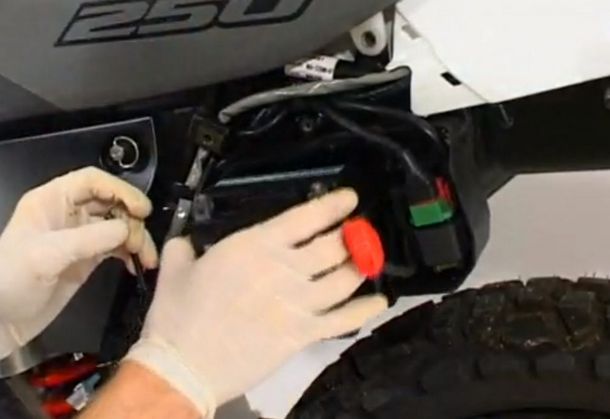
Brakes and clutch
If in the last two years or 19,000 kilometers traveled you did not change the brake fluid or clutch oil, now is a great time to do it. Liquids in these systems absorb moisture, which can otherwise lead to corrosion or later problems.
As the brake fluid can damage the paint and the plastic, protect such surfaces during the replacement and re-pouring process. If there is little fluids and drops where you do not need, immediately clean the place with a mild detergent and with a little water.
Cooling system
If your motorcycle has water cooling, and the fluid has not changed for the last two years or 38,600 kilometers, now is the right moment.
The cooling fluid must be clean and mixed with distilled water in a precisely determined proportion. If you are unsure of the temperature at which your liquid can withstand without getting enough water, check with the measuring devices that can now be purchased in each car parts store. If the cooling fluid gets too hot, it will spread, which can permanently damage the engine.
Use suitable distilled water for the use of distilled water, as it is not possible to find minerals in it, which in the second case can lead to reaction with aluminum parts of the engine and cooler and lead to corrosion.
If the planned standstill period is longer than 6 months, completely drain the fluid from the system, which will completely protect you from corrosion. It is important that you do not forget to refill the liquid after this time.
If the fluid is fresh, you can save it for later.
Washing motorcycle (external corrosion protection)
Insects and dirt can be fatal for certain parts, so it is best to wash completely and dry the motorbike before the "winter sleep", and then wax it and sprinkle it if possible.
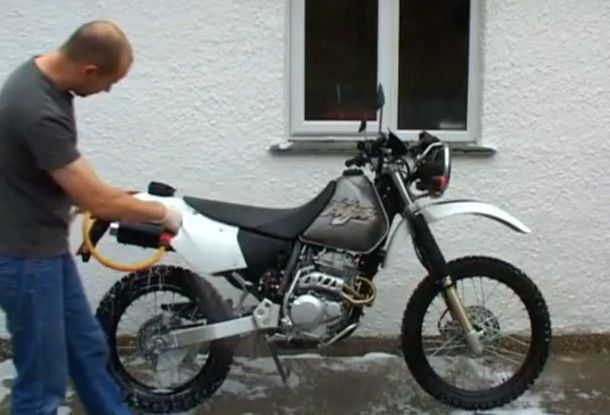
Metal parts should be sprayed with WD spray, silicone lubricant or similar protective agent and avoiding contact with brake discs and jaws. If the seat is made of vinyl, a protective device intended for it should be applied.
As the rodents do not use the exhaust for their new home, and for additional corrosion protection, spray the inner part of the exhaust with WD-40 spray or similar lubricant, so that a light layer on the surface is made.Then apply the same cloth to the same substance and press it into the exhaust. Finally, wipe the exhaust with a plastic bag to prevent moisture from penetrating.
Final steps
What else you can do is push your tires to the recommended pressure and lubricate the chain thoroughly if there is a need for it.
Place the motorcycle on the pillar and position it so that the front wheel is not on the ground.
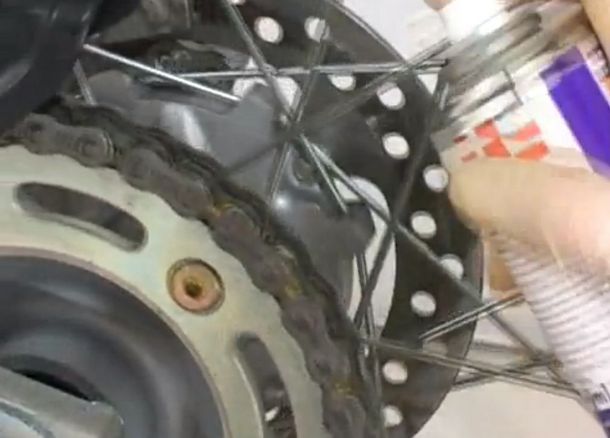
Do not forget, because of the cold air and in combination with the inevitable slight leak of air, the pressure will fall, so if you do not have a pendulum it's not a waste to pump tires in the middle of winter.
Cover the motorcycle for motorcycles, even if you hold it in the garage, because it is an excellent protection against dust and other external factors.
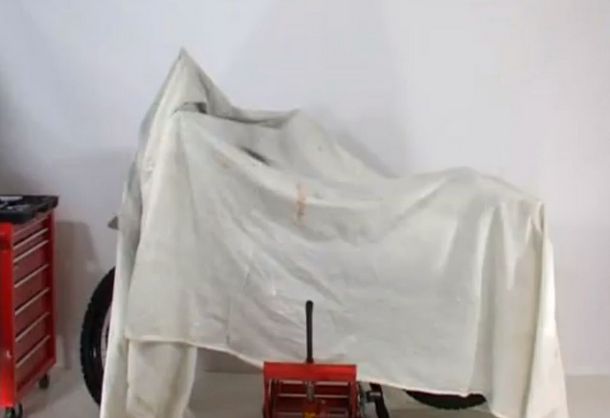
If you do not have the time or do not want to bother about the necessary preparations for protecting your motorcycle, look for a motorcycle rider , and in that case be ready to extract the necessary resources for it.


Primjedbe
Objavi komentar